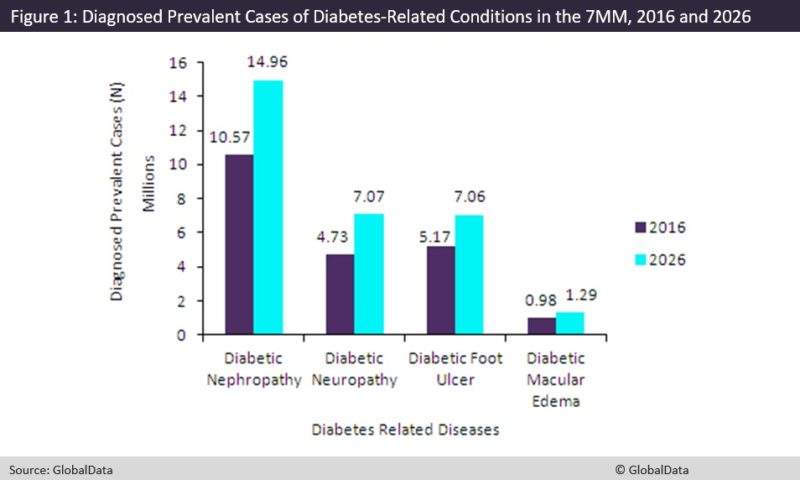
Diabetes is a major health issue that affects more and more people each year.
The World Health Organization (WHO) estimated that the number of people with diabetes worldwide has quadrupled, increasing from 108 million in 1980 to 422 million in 2014. As the treatment of diabetes has improved over the last several decades, people with diabetes are living longer. However, a consequence of living longer with diabetes is an increase in the development of chronic diabetes-related diseases such as diabetic nephropathy, diabetic neuropathy, diabetic foot ulcer, and diabetic macular edema. Uncontrolled diabetic-related diseases can lead to significant health issues such as blindness, kidney failure, and lower limb amputation.
As the burden of diabetes is expected to increase over the next decade, the prevalent cases of related diabetic complications will also be a significant burden on healthcare systems worldwide.
GlobalData epidemiologists estimated that among the seven major markets (7MM: US, France, Germany, Italy, Spain, UK, and Japan), the number of people with diagnosed type 1 diabetes will increase from 3.23 million in 2016 to 4.47 million in 2026. GlobalData epidemiologists also estimated that the number of adults ages 20 years and older with type 2 diabetes will increase from 56.06 million to 77.82 million in the same time period.
The number of diabetes-related conditions will also increase from 2016–2026, as shown in the figure below. Diabetic nephropathy make up the largest diabetes-related conditions among the four studied. One major concern about these diabetes-related conditions is that they are often silent in the early stages, with little to no symptoms, but can be devastating and irreversible in the late stages.

How well do you really know your competitors?
Access the most comprehensive Company Profiles on the market, powered by GlobalData. Save hours of research. Gain competitive edge.

Thank you!
Your download email will arrive shortly
Not ready to buy yet? Download a free sample
We are confident about the unique quality of our Company Profiles. However, we want you to make the most beneficial decision for your business, so we offer a free sample that you can download by submitting the below form
By GlobalDataDiabetes-related conditions are resultant from high blood sugar levels that damage various organs and blood vessels. Blood vessels in the kidneys lose the ability to filter out waste, which can eventually lead to kidney failure in diabetic nephropathy. The blood vessels in the eyes are especially vulnerable to uncontrolled long-term exposure to high blood sugar, leading to retina damage, swelling, and blindness as result of diabetic retinopathy and diabetic macular edema. High blood sugar can also negatively affect nerve functions. When nerve damage results in pain, it is known as diabetic neuropathy. However, nerve damage can also result in loss of sensation, such is the case in diabetic foot ulcer development, where sensation in the feet is lost.
Because of this, patients can develop sores and infections in the feet without realizing it, which can eventually lead to the amputation of affected limbs. Diabetes-related complications are serious illnesses that carry a burden that will will increase over time, mirroring the increase in diabetes burden. These four diabetes-related diseases accounted for more than $8B in drug sales in 2018—a substantial sum that will increase over time due to the increase in diabetes burden. For more information on the diabetes-related complications, see GlobalData’s epidemiology forecast series listed below.
Related Reports
- GlobalData (2017). EpiCast Report: Type 2 Diabetes – Epidemiology Forecast to 2027, July 2017, GDHCER154-17
- GlobalData (2018). Painful Diabetic Neuropathy – Epidemiology Forecast to 2026, January 2018, GDHCER178-18
- GlobalData (2013). EpiCast Report: Diabetic Nephropathy – Epidemiology Forecast to 2022, December 2013, GDHCER52-13
- GlobalData (2016). EpiCast Report: Diabetic Foot Ulcers – Epidemiology Forecast to 2025, December 2016, GDHCER143-16
- GlobalData (2017). EpiCast Report: Macular Edema – Epidemiology Forecast to 2026, November 2017, GDHCER169-17








Related Company Profiles
Who LLC